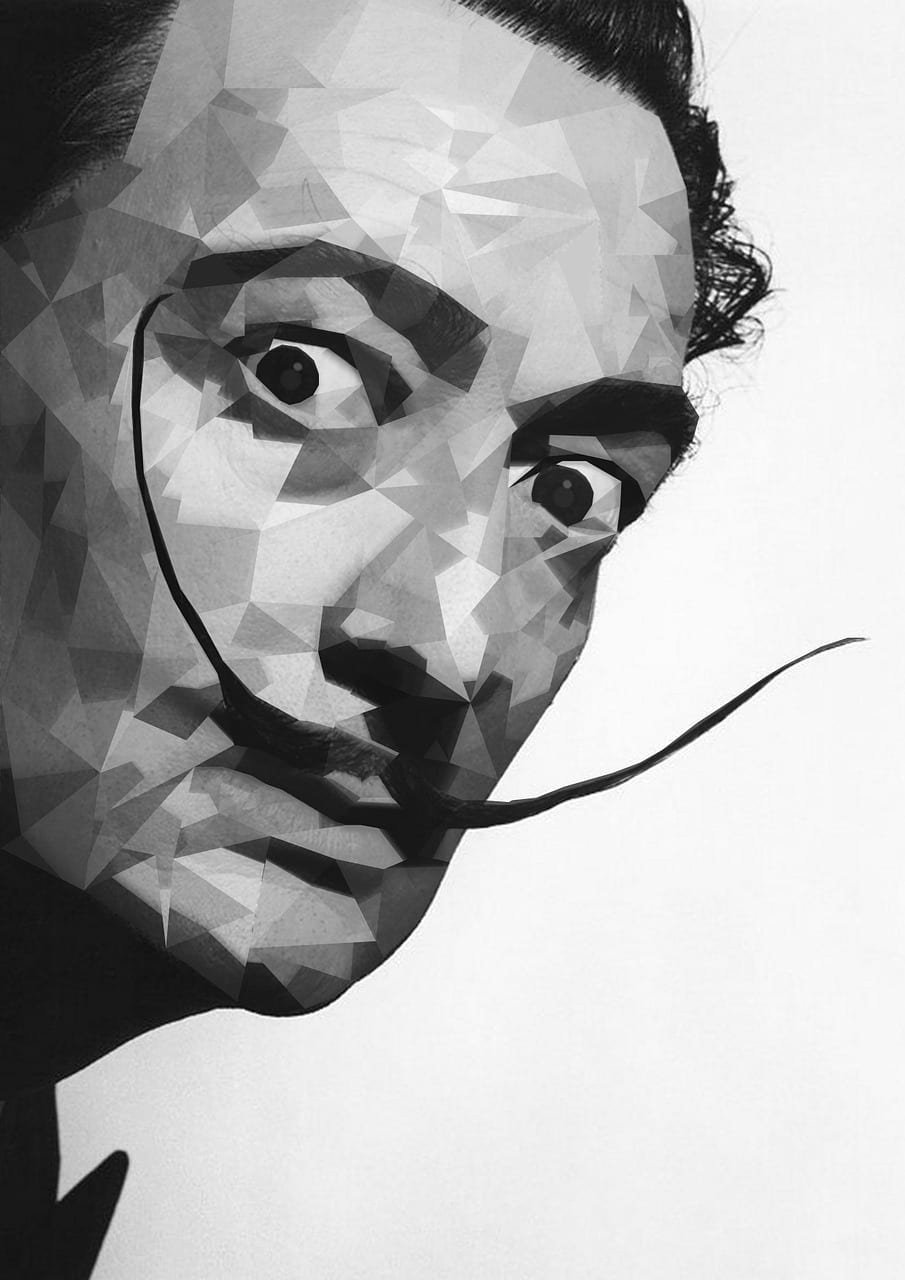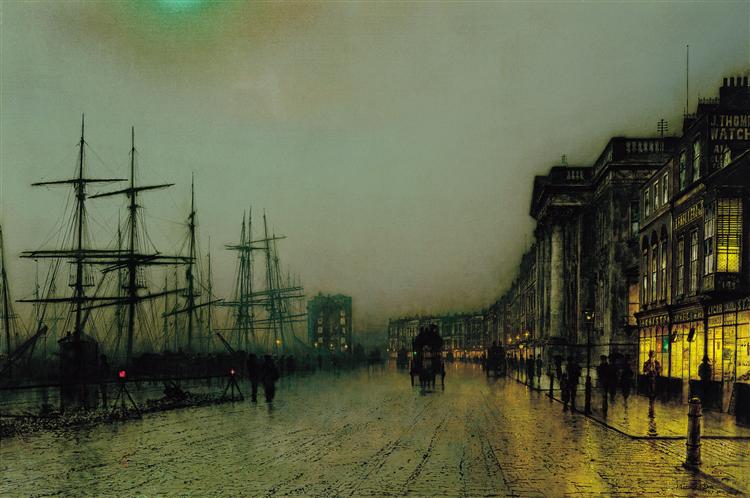
Cityscape art is a form of artwork, that focuses on the physical aspects of a city. Modern and contemporary art enthusiasts can recognize the significant value of cityscape and the place it has in the artistic world. With each artist adding their own style onto a city. These cityscapes give us a special view of how an artist views the world. From Paris in the eyes of Claude Monet or Madrid through the eyes of Antonio Lopez.
Cityscape painting thrived after World War II, previously showing up in the repertory of the theoretical expressionist painters. For instance in the “City scene” by Joan Mitchell (1955, Art Institute of Chicago) or in some nervy pictorial tests by Willem de Kooning.
1.Canny Glasgow-John Atkinson Grimshaw.
John Atkinson Grimshaw was an English Victorian era painter and landscapist. He is best known for his nocturnal views on a city. He is considered one of the best painters of the era and his work has gained much admiration and popularity. Grimshaw’s adoration for authenticity originated from an enthusiasm for photography, which would ultimately fit the inventive cycle. In spite of the fact that he is self-trained, he is known to have used a camera obscura or focal points to extend scenes onto canvas. This compensated for his weaknesses as a sketcher and his defective information on viewpoint. Many perceived his authority of shading, lighting, and shadow, his special capacity to incite forceful passionate reactions in the watcher.
2. Gustave Caillebotte – Paris Street- Rainy Day.
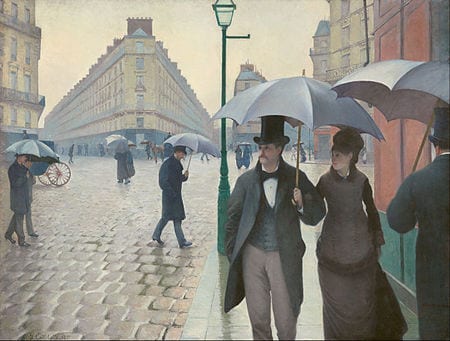
This is Gustave Callibotte’s best-known work of art. The artwork doesn’t present a genial state of mind. The figures appear to be generally confined, and their looks are to a great extent sad. They seem to hustle as opposed to walking around the roads, ingested in their own contemplation. Characteristic of the situating of the figures, the heads and eyes of the principle couple are confronted away from the man moving toward them from their right.
Caillebotte replicates the impact of a camera focal point in that the focuses at the focal point of the picture appear to swell. He likewise reproduces the centering impact of the camera in the manner that it hones certain subjects of a picture, however not others. A similar design is found in the general clearness of the picture. The closer view is in the center, however marginally smeared- the center ground has sharp, clear edges and very much characterized subjects. The foundation blurs into the distance, getting increasingly more foggy the farther back the eye voyages. He makes the center ground segment more understood, mirroring the impact of a camera.
3. Francis Hopkinson Smith – New York Cityscape – 1900
Francis Hopkinson Smith was a creator, craftsman and engineer and an incredible grandson of Francis Hopkinson, one of the underwriters of the Declaration of Independence. Like his dad, the more youthful Francis Hopkinson Smith was enriched with flexibility, during his lifetime he had three effective vocations, all of which brought him notoriety.
After the American Civil War, he and accomplice James Symington set up a designing firm they ran for a very long time. They undertook such striking activities as the development of the establishments for the Statue of Liberty, the Block Island embankment, the Staten Island seawall, and the Race Rock Lighthouse.
4. Edward Hopper -Nighthawks, 1942
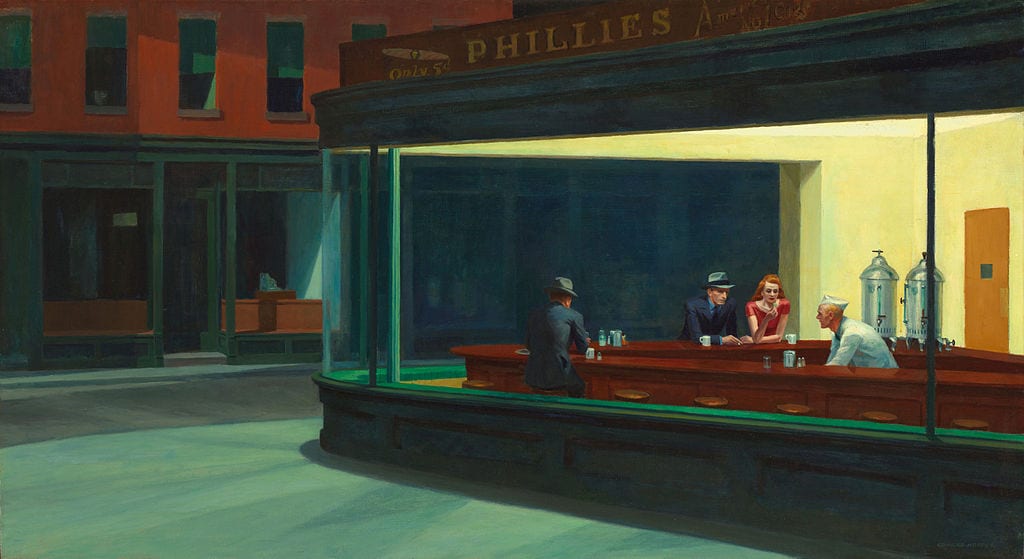
Image via- Wikimedia Commons
Viewed as one of the main pragmatist painters of 20th century America. Edward Hopper had a special and particular vision when depicting void cityscapes, scenes, and disconnected figures. Permeated with interpretative delivering, his canvases caught the disposition and the vibe of the twentieth century. The city around evening time was an incessant subject in Hopper’s work. Hopper will consistently be viewed as “the painter of metropolitan dejection”. He leans toward the scenes that occur inside lodgings and lofts and the creator of the celebrated “Nighthawks”. The painting depicts a lonely café called Phillies, which plays right into his motif.
5. Richard Diebenkorn- seawall 1957
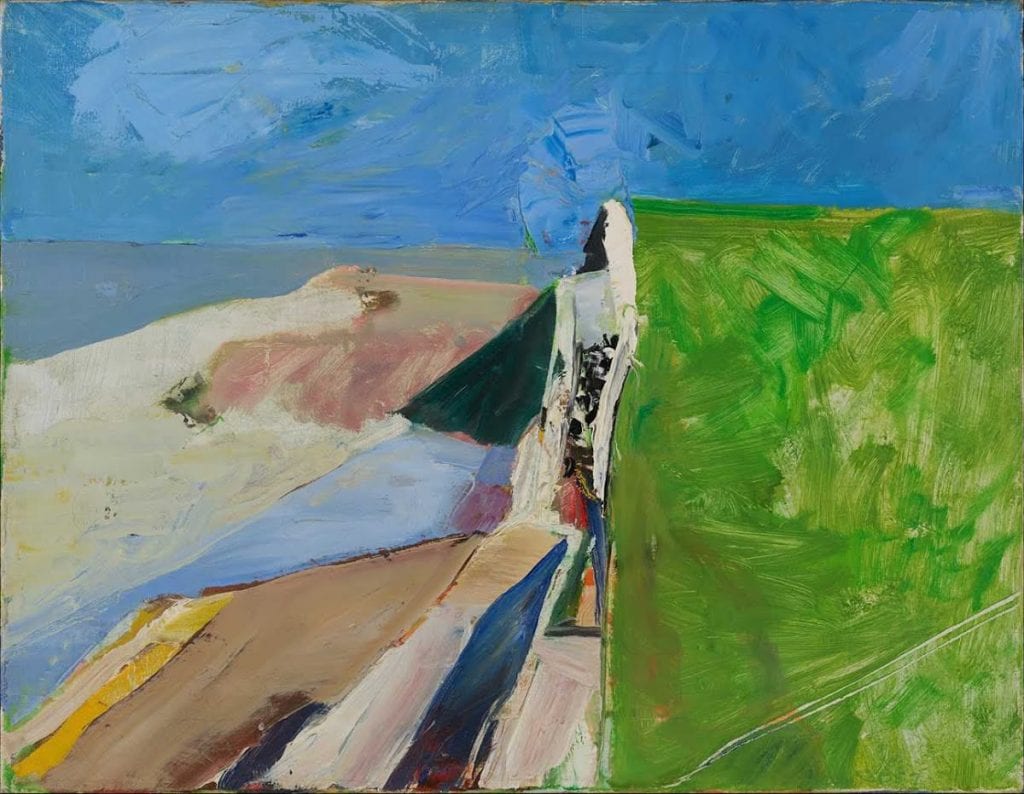
The act of the American painter Richard Diebenkorn has enormously characterized the California School of Abstract Expressionism. On a very basic level, a West Coast craftsman was significantly affected by the environmental factors of New Mexico and California. Diebenkorn deserted his severe adherence to digest expressionism and started to work in a more authentic style. By the mid-1950s, Diebenkorn had become a significant allegorical painter, in a style that connected Henri Matisse and conceptual expressionism. . His topic during this period included insides, scenes, and still life, just as the human figure.
6. Piet Mondrian-Broadway Boogie Woogie 1942
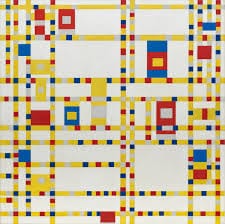
Piet Mondrian’s canvas Broadway Boogie-Woogie (1942–43) at The Museum of Modern Art in Manhattan was profoundly powerful in the school of unique mathematical artistic creation. The piece is composed of various shining squares of brilliant shading that jump from the canvas, at that point seem to sparkle, bringing the watcher into those neon lights. In this work of art and the incomplete Victory Boogie Woogie (1942–1944), Mondrian supplanted previous strong lines with lines made from little bordering square shapes of shading. They were made partially by utilizing little bits of paper tape in different tones. Bigger unbounded square shapes of shading accentuate the plan, some with more modest concentric square shapes inside them. While Mondrian’s works of the 1920s and 1930s will in general have a practically logical gravity about them. These are brilliant, energetic compositions, mirroring the cheery music that roused them and the city where they were made.
7. Childe Hassam-The Avenue in the rain, 1917
Childe Hassam (1859-1935), probably the most delegate figures of American Impressionism, whose artistic creations of “banners” are yet one of the most effectively recognizable pictures of American work of art. The most particular and acclaimed works of Hassam’s later life contain the arrangement of around thirty artworks known as the “Banner arrangement”. He started these in 1916 when he was enlivened by a “Readiness Parade” (for the US contribution in World War I). It was hung on Fifth Avenue in New York (renamed the “Road of the Allies” during the Liberty Loan Drives of 1918). Thousands took an interest in these motorcades, which frequently went on for more than twelve hours.
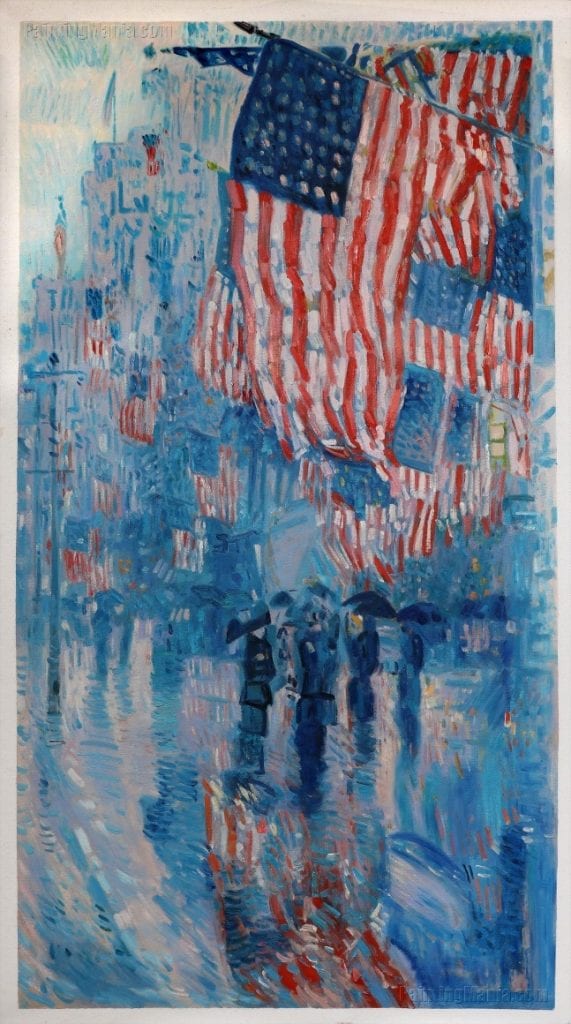
Hassam’s banner compositions cover all seasons and different climate and light conditions. Hassam offers an enthusiastic expression without obvious reference to marches, officers, or war, aside from one picture indicating a banner shouting “Buy Liberty Bonds”.
8. at night, 1897
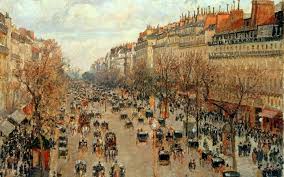
Camille Pissarro was a French scene craftsman most popular for his impact on Impressionist and Post-Impressionist composition. Through the compositions Pissarro finished as of now, he records Sydenham and the Norwoods. This was when they were simply as of late associated by railroads, yet before the development of the suburbs. One of the biggest of these works of art is a perspective on St. Bartholomew’s Church at Lawrie Park Avenue, usually known as The Avenue, Sydenham, in the assortment of the National Gallery in London. In the astounding “The Boulevard Montmartre at Night” by Camille Pissarro (1897, London, National Gallery). The Impressionist painters were additionally pulled in by the imaginative components of the advanced city, particularly those identified with the railroad world.
9. Wayne Thiebaud – Valley Streets, 2003
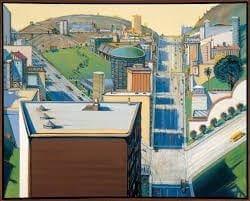
Most popular for his beautiful Pop workmanship compositions of typical articles like pies, lipsticks, gelatos, cakes, and wieners. Wayne Thiebaud has spent a huge piece of his profession painting scenes and cityscapes. His arrangement of scenes and cityscapes dates from the mid-1970s after he got comfortable in San Francisco. Utilizing his trademark energetic palette and fastidious painterly methods, he depicted surprising perspectives on San Francisco’s roads and structures. The artwork Valley Streets is one of his new works and it was painted in 2003.
10. Richard Estes – Gordon’s Gin, 1968
The quintessential New York craftsman and suffering head of the Photorealist development, Richard Estes makes his works of art from photos. With a million stories inserted, his works appear as though stage sets. Remaking the truth in strikingly persuading delivery, his compositions regularly show intelligent surfaces that improve the survey insight. New York City is his never-ending motivation, and he portrays it as just a New Yorker could. Portraying the city’s famous locales, he likewise offers life to its unknown occupants. The artistic creation Gordon’s Gin is a piece of his notorious New York City works
Works Cited
Camille Pissarro Biography. (n.d.). Retrieved from Biography.com: https://www.biography.com/artist/camille-pissarro
Childe Hassam Wikipedia. (n.d.). Retrieved from Wikipedia: https://en.wikipedia.org/wiki/Childe_Hassam
Fernández, G. (n.d.). Painting the city: the history of cityscapes. Retrieved from Theartwolf.com: http://www.theartwolf.com/articles/cityscape-painting.htm
Lexington, T. (2017, April 22). 10 Urban Landsape Artists You Have to Know. Retrieved from thebluereview.net: https://thebluereview.net/10-urban-landsape-artists-you-have-to-know-bb2507a5aa3c
Martinique, E. (2016, June 16). Stunning Art Cityscapes of Contemporary Art. Retrieved from Widewall: https://www.widewalls.ch/magazine/cityscapes-contemporary-artPiet Mondrian Wikipedia. (n.d.). Retrieved from wikipedia: https://en.wikipedia.org/wiki/Piet_Mondrian

